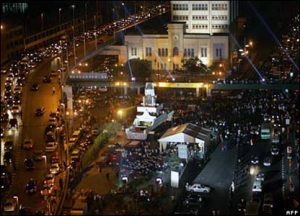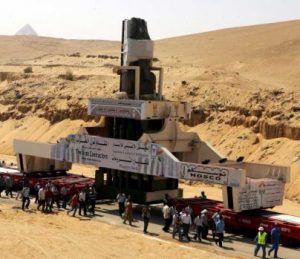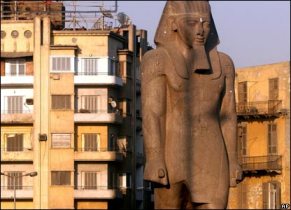
A huge granite statue of the ancient Egyptian Pharaoh Ramses II has arrived at its new home to the Grand Egyptian Museum, which is to open near the Giza Pyramids outside Cairo. For 50 years, it had stood in a Cairo square, hemmed in by bridges, an underground railway and a mosque.There were worries that heavy pollution was damaging the 3,200-year-old statue, which is 11 metres (36 feet) high and weighs about 83 tonnes.
It took 10 hours for the colossus to travel the 2km to its new home.
The council of antiquities has taken extreme precautions to ensure the move goes well, even doing a dry-run with a fake statue.Trees and other overhead obstructions on the route have been moved.
The statue was transported upright through Cairo at a stately pace on two flatbed trucks.
Tens of thousands of people came out to watch it go by.
The statue was transported in one piece and a steel cage was built around it to hold it steady.
The head of Ramses, protruding from the protective steel, was wrapped in plastic and thick padding, but its face was visible to the crowds lining the streets
The statue will be renovated as its new home is built. The museum, which also will house King Tutankhamun's mummy and other treasures, is not expected to open until 2010.
Rameses II
1279-1213 B.C. 19th Dynasty
The son of Seti I and Queen Tuya was the third king of the 19th Dynasty. Called Ramesses the Great, he lived to be 96 years old, had 200 wives and concubines, 96 sons and 60 daughters. One son, Prince Khaemwese, was a high priest of Ptah, governor of Memphis, and was in charge of the restoration of the Pyramid of Unas. This son was buried in The Serapeum. Ramesses II outlived the first thirteen of his heirs. Ramesses was named co-ruler with his father, Seti I, early in his life. He accompanied his father on numerous campaigns in Libya and Nubia. At the age of 22 Ramesses went on a campaign in Nubia with two of his own sons. Seti I and Ramesses built a palace in Avaris where Ramesses I had started a new capital. When Seti I died in 1290 B.C., Ramesses assumed the throne and began a series of wars against the Syrians. The famous Battle of Kadesh is inscribed on the walls of Ramesses temple.

Ramesses' building accomplishments are two temples at Abu Simbel, the hypostyle hall at Karnak, a mortuary complex at Abydos, the Colossus of Ramesses at Memphis, a vast tomb at Thebes, additions at the Luxor Temple, and the famous Ramesseum. Among Ramesses' wives were Nefertari, Queen Istnofret, his two daughters, Binthanath and Merytamon, and the Hittite princess, Maathornefrure. Ramesses was originally buried in his tomb in the Valley of the Kings. Because of the widespread looting of tombs during the 21st Dynasty the priests removed Ramesses body and took it to a holding area where the valuable materials such, as gold-leaf and semi-precious inlays, were removed. The body was then rewrapped and taken to the tomb of an 18th Dynasty queen, Inhapi. The bodies of Ramesses I and Seti I were done in like fashion and all ended up at the same place. Amenhotep I's body had been placed there as well at an earlier time. Seventy-two hours later, all of the bodies were again moved, this time to the Royal Cache that was inside the tomb of High Priest Pinudjem II. The priests documented all of this on the linen that covered the bodies. This “systematic” looting by the priests was done in the guise of protecting the bodies from the "common" thieves.
Ramesses was followed to the throne by his thirteenth son, with his queen Istnofret, Merenptah.
Statue
In August 2006 contractors moved the 3,200-year-old statue of him from Ramses Square to save it from exhaust fumes that were causing the 83-ton statue to deteriorate. The statue was originally taken from a temple in Memphis. The new site will be near the Grand Museum of Egypt.




